The 6 Healthiest Flours for Every Use

miniseries / Getty Images
Medically reviewed by Karina Tolentino, RD
Flour has been an important part of the human diet for at least 30,000 years. Today, the flour most often used to make popular foods like bread, pastries, and pasta is all-purpose flour, which undergoes a refining process that strips away the nutrient-dense bran and germ from wheat kernels.
While all-purpose flour makes delicious baked goods, it's not the most nutritious choice as it's lower in fiber, vitamins, and minerals than more nutritious options, such as whole-grain flours.
Fortunately, there are plenty of alternatives to all-purpose flour that are packed with nutrients and safe for people following gluten and grain-free diets.
Here are six of the healthiest flours you can eat.
1. Almond Flour
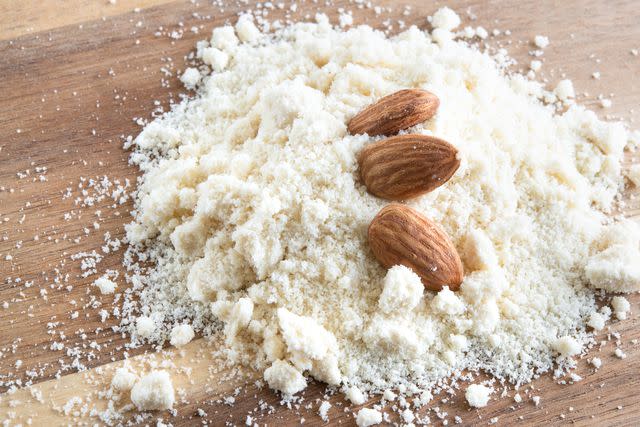
Roberto Machado Noa / Getty Images
Almond flour is one of the most popular all-purpose flour alternatives for people who can't or prefer not to consume gluten, an umbrella term used to describe a group of proteins called found in grains such as wheat, barley, and rye.
Some people need to avoid gluten for medical reasons while others follow diets that exclude gluten-containing grains. For example, grains, including gluten-containing grains, are off limits for those following the paleo diet, an eating pattern meant to resemble the diet of our ancient ancestors.
Since almond flour is made from ground, blanched almonds, it's naturally gluten-free. In addition to being gluten-free, almond flour is much lower in carbs and higher in fat than all-purpose flour, which is why it's a staple ingredient in low-carb and keto recipes, like baked goods.
Here’s the nutrition breakdown for a 1/4-cup serving of almond flour:
Calories: 160
Carbs: 6 grams (g)
Fiber: 3 g
Protein: 6 g
Fat: 14 g
Almond flour is low in carbs and high in healthy fats. It's also a good source of protein and fiber, nutrients that help you feel full after eating. Almond flour provides several vitamins and minerals, but is especially high in magnesium, a mineral needed for healthy blood sugar and blood pressure regulation, muscle and nerve function, and more.
A 1/4 cup serving of almond flour covers 19% of your daily magnesium needs, making it magnesium-rich food.
Almond flour can be used to make moist, gluten-free baked goods, like muffins and cakes, and makes an excellent stand-in for bread crumbs when coating fish and chicken. When using almond flour in place of all-purpose flour, it's recommended to use 3/4 cup of almond flour for every one cup of all-purpose flour in your recipe.
Almond flour has a much different texture than wheat-based flours, so you may have to combine almond flour with other flours, such as coconut flour, to reach your desired outcome.
2. Coconut Flour
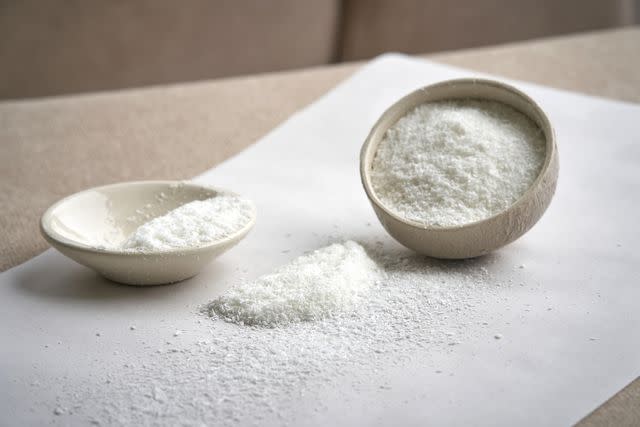
Jose Luis Raota / Getty Images
Coconut flour is another gluten-free flour made from dried and ground coconut flesh. This byproduct of coconut milk and coconut oil production has a mild taste and is much more nutritious than all-purpose flour.
It's higher in protein, fat, and fiber than all-purpose flour and is a better source of vitamins and minerals.
A 1/4-cup serving of coconut flour provides:
Calories: 120
Carbs: 18 g
Fiber: 10 g
Protein: 6 g
Fat: 3 g
Coconut flour is lower in carbs and much higher in fiber compared to wheat-based flour. It also has a lower glycemic index, meaning it has a less of an impact on blood sugar levels than wheat flour. Coconut flour has a glycemic index (GI) of 35, which is considered low, while wheat flour has a GI of around 85, which is considered high. This makes coconut flour a better choice for people with blood sugar regulation issues, such as those with diabetes.
Due to its high fiber content, coconut flour can also boost the health of the digestive system and may lower heart disease risk factors, such as LDL cholesterol. A 1/4 cup serving of coconut flour provides 10 g of fiber, which covers nearly 36% of your daily fiber needs. Coconut flour is also a good source of the minerals potassium and iron, which are needed for blood pressure regulation and red blood cell production, respectively.
Coconut flour can be used in sweet and savory recipes and can be used as a partial replacement for wheat flour in recipes like pasta and cookies. Experts recommend using a 1/4 to 1/3 cup of coconut flour for every cup of regular flour called for in a recipe. Keep in mind that you may have to combine coconut flour with other flours and increase the number of eggs in your recipe to reach your desired texture.
3. Buckwheat Flour
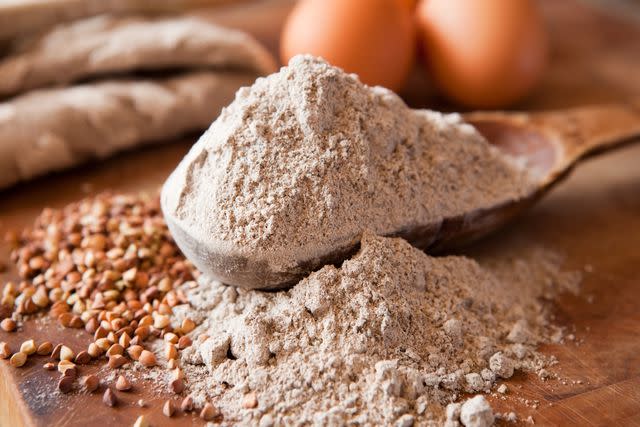
MonaMakela / Getty Images
Buckwheat flour is naturally gluten-free flour that’s packed with nutrients, such as fiber, vitamins, and minerals. It's also a rich source of protective plant compounds with powerful antioxidant properties, such as flavonoids and phenolic acids.
For example, buckwheat contains flavonoids such as rutin and quercetin, which may help support brain health. A 2021 study that included data on over 76,000 U.S. adults found that people with the highest total flavonoid intake had a 19% lower risk of cognitive decline compared to people with the lowest intake.
Additionally, buckwheat flour provides several vitamins and minerals, such as iron, potassium, and B vitamins.
Here’s the nutrition breakdown for a ¼ cup serving of buckwheat flour:
Calories: 110
Carbs: 21 g
Fiber: 3 g
Protein: 4 g
Fat: <1 g
Buckwheat is technically a seed, so buckwheat flour is safe for people following grain-free diets, like paleo diets.
It's important to note that although buckwheat flour is nutritious, it has a slightly bitter taste that may alter the flavor of recipes. This is why buckwheat is usually mixed with other, mild-tasting flours, such as coconut flour.
Remember, buckwheat is gluten-free, so it can't be used as a 1:1 replacement for wheat flour. However, you can swap around 25% of wheat flour with buckwheat flour in recipes like cookies and cake to give baked goods a more complex flavor and dense texture.
4. Oat Flour
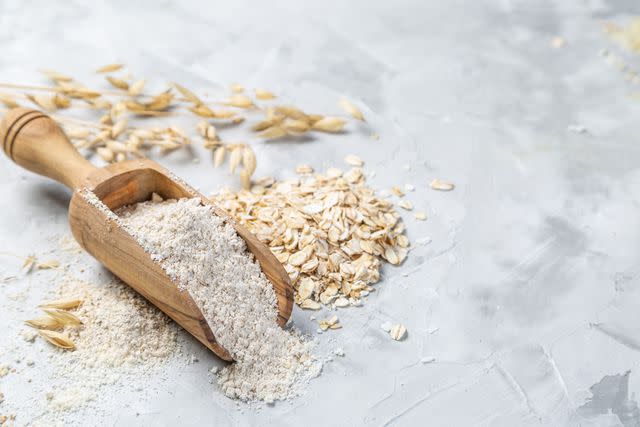
a_namenko / Getty Images
Eating oats has been linked to a number of health benefits, from reducing heart disease risk factors like high LDL cholesterol to promoting weight loss.
Oat flour also provides beta-glucans, which are soluble fibers that help promote the health of the heart and digestive system. Beta-glucans reduce cholesterol levels by preventing its absorption in the digestive tract and increasing its excretion through the stool. Beta-glucans also support digestive health by promoting the growth of beneficial probiotic bacteria and the production of short-chain fatty acids (SCFAs), which are compounds that fuel the cells lining the colon, regulate intestinal inflammation, and promote overall intestinal health.
Oat flour is also a good source of fiber, protein, and several vitamins and minerals.
A 1/4 cup serving of oat flour provides:
Calories: 120
Carbs: 22 g
Fiber: 3 g
Protein: 3.99 g
Fat: 2 g
Oat flour is naturally gluten-free and is often used in gluten-free flour blends. It has a mild, nutty flavor that works well in baked goods like breads, cakes, and muffins.
Oat flour can be used as a 1:1 replacement for all-purpose flour by weight. However, oat flour is lighter than all-purpose flour, so baking experts generally recommend using 1¼ cup unpacked oat flour as a replacement for one cup of unpacked all-purpose flour.
5. Einkorn Flour
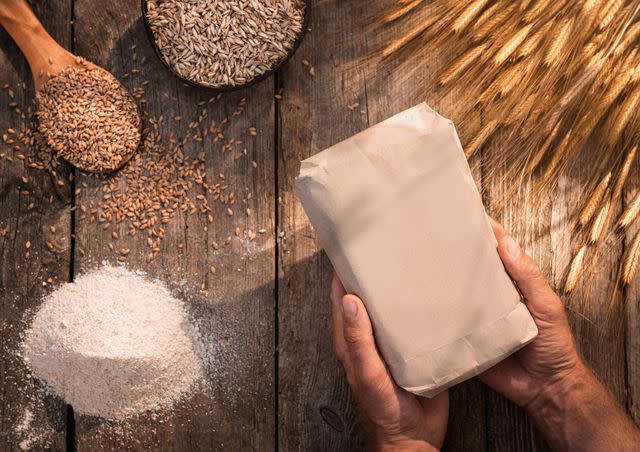
Nastco / Getty Images
If you're looking for a more nutritious gluten-containing flour, consider einkorn flour. Einkorn is a type of ancient wheat that has higher levels of certain nutrients and antioxidants than modern-day wheats. For example, studies show that einkorn is higher in carotenoid compounds such as lutein and zeaxanthin than modern wheats.
Studies show that ancient flours, like einkorn flours, contain around seven times more carotenoids than standard flours, like all-purpose flour.
Carotenoids are plant pigments that have potent antioxidant and anti-inflammatory effects that may benefit health in several ways. For example, studies show that regularly consuming foods high in carotenoids like lutein and zeaxanthin may reduce the risk of age-related macular degeneration (ARMD), an eye disease that’s currently the leading cause of vision loss in older people.
Here's the nutrition breakdown for a 1/4 cup serving of einkorn flour:
Calories: 100
Carbs: 20 g
Fiber: 2 g
Protein: 4 g
Fat: <1 g
In addition to being a good source of antioxidants, einkorn flour is also high in minerals like manganese and selenium.
Since einkorn contains gluten, it can be used as a 1:1 replacement for other wheat-based flours. However, einkorn absorbs liquids slower than other flours, so you may need to reduce the liquid content of some recipes, like bread recipes, by about 15%.
Although einkorn contains gluten, it has a different gluten protein ratio than modern types of wheat and some studies suggest that it may be easier to digest and less toxic for people who are sensitive to gluten.
6. Chickpea Flour

natashamam / Getty Images
Chickpea flour is a gluten-free flour that's made from dried and ground chickpeas. Also known as gram flour and besan, chickpea flour is a staple in Indian and Caribbean cuisine and is a main ingredient in dishes like pancakes, fritters, and breads.
Chickpea flour is highly nutritious and is a good source of protein, fiber, and vitamins and minerals such as folate and manganese.
Here’s the nutrition breakdown for a ¼ cup serving of chickpea flour:
Calories: 89
Carbs: 13.3 g
Fiber: 2.4 g
Protein: 5.15 g
Fat: 1.54 g
Chickpea flour is low in calories but provides essential nutrients, like folate, a B vitamin that plays critical roles in growth, development, and the maturation of red blood cells. Folate is especially important during pregnancy, as it's required for fetal growth and brain development. Chickpeas and chickpea flour are a rich source of folate, with a 1/4 cup serving of chickpea flour providing 25% of your daily needs for this nutrient.
In addition to folate, chickpea flour is a good source of minerals, such as manganese and iron.
Chickpea flour has a nutty taste and has powerful binding properties, making it a popular addition to gluten-free baked goods. It can be mixed with other gluten-free flours to replace all-purpose flour and can also be used on it's own in sweet and savory recipes.
Some people also use chickpea flour to make vegan egg and cheese replacements. For example, chickpea flour can be mixed with water, baking soda, and aquafaba—the liquid leftover from cooked or canned chickpeas—to create an eggless omelette.
What to Look For
When shopping for flour, it's important to choose a product based on its nutritional value and your health needs. For example, if you're unable to consume gluten or prefer to eat gluten-free foods, it's best to choose gluten-free flour products such as almond, coconut, or buckwheat flour.
Additionally, if you're shopping for flours for a specific purpose, such as baking, you should be familiar with the properties of the flour. While some flours can be used as a 1:1 replacement for all-purpose flour, others needs to be mixed with additional ingredients in order to mimic the properties of all-purpose flour.
When subbing flours for all-purpose flour or other wheat-based flours in recipes, it's best to follow replacement instructions, which may recommend using more or less of the replacement flour or adding additional ingredients, such as more water, oil, or eggs.
A Quick Review
Most people regularly enjoy flour-containing products, like bread, pastries, and pasta.
While all-purpose flour is a useful kitchen ingredient, other flours, such as coconut flour, almond flour, and chickpea flour are more nutritious and may offer more health benefits.
If you're looking for an easy way to boost your nutrient intake or are following a diet that restricts grains or gluten, consider trying out some of the flours on this list.
For more Health.com news, make sure to sign up for our newsletter!
Read the original article on Health.com.

